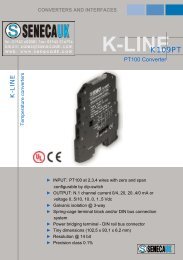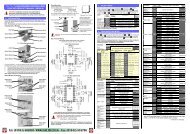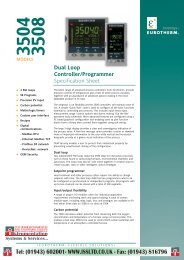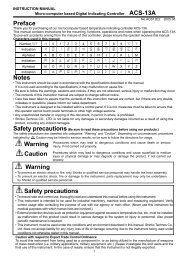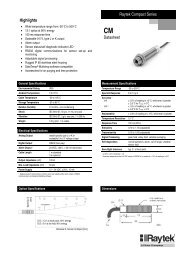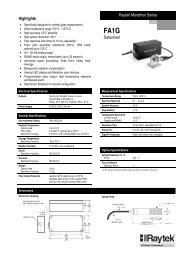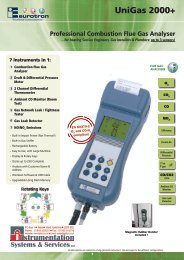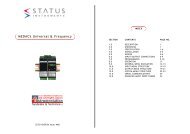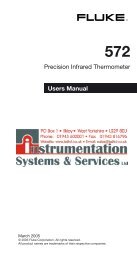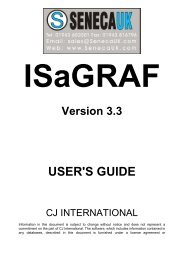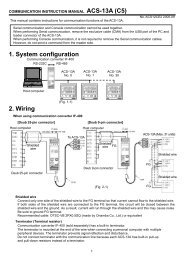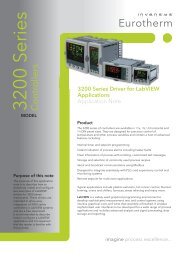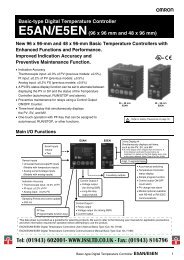to download the Eurotherm piccolo⢠Manual in PDF format
to download the Eurotherm piccolo⢠Manual in PDF format
to download the Eurotherm piccolo⢠Manual in PDF format
Create successful ePaper yourself
Turn your PDF publications into a flip-book with our unique Google optimized e-Paper software.
User <strong>Manual</strong><br />
Piccolo Range<br />
2.8 Output 3<br />
Output 3 is only available <strong>in</strong> <strong>the</strong> models P108 and P104. It will be ei<strong>the</strong>r a Relay or Analogue output depend<strong>in</strong>g on<br />
<strong>the</strong> order code.<br />
For output functions, see Quick Start Code <strong>in</strong> section 4.1.1. or ‘P’ codes <strong>in</strong> section 5.2.<br />
2.8.1 Relay Output (Form A, normally open)<br />
3A<br />
3B<br />
• Isolated output 300Vac CAT II<br />
• Contact rat<strong>in</strong>g: 2A 230Vac +15% resistive<br />
2.8.2 DC Output<br />
3A<br />
3B<br />
+<br />
-<br />
• Isolated output 300Vac CAT II<br />
• Software configurable: 0-20mA or 4-20mA<br />
• Max load resistance: 500Ω<br />
• Calibration accuracy: 0.5%, +100μA<br />
2.9 Output 4 (AA Relay)<br />
Output 4 is a changeover relay (Form C) and is available <strong>in</strong> all models.<br />
For output functions, see Quick Start Code <strong>in</strong> section 4.1.1 or ‘P’ Codes <strong>in</strong> section 5.2.<br />
AA<br />
AB<br />
AC<br />
• Isolated output 300Vac CAT II<br />
• Contact rat<strong>in</strong>g: 2A 230Vac +15% resistive<br />
2.10 General Note About Relays and Inductive Loads<br />
High voltage transients may occur when switch<strong>in</strong>g <strong>in</strong>ductive loads such as some contac<strong>to</strong>rs or solenoid valves.<br />
Through <strong>the</strong> <strong>in</strong>ternal contacts, <strong>the</strong>se transients may <strong>in</strong>troduce disturbances which could affect <strong>the</strong> performance of<br />
<strong>the</strong> <strong>in</strong>strument.<br />
For this type of load it is recommended that a ‘snubber’ is connected across <strong>the</strong> normally open contact of <strong>the</strong> relay<br />
switch<strong>in</strong>g <strong>the</strong> load. The snubber recommended consists of a series connected resis<strong>to</strong>r/capaci<strong>to</strong>r (typically<br />
15nF/100Ω). A snubber will also prolong <strong>the</strong> life of <strong>the</strong> relay contacts.<br />
A snubber should also be connected across <strong>the</strong> output term<strong>in</strong>al of a triac output <strong>to</strong> prevent false trigger<strong>in</strong>g under<br />
l<strong>in</strong>e transient conditions.<br />
2A<br />
2B<br />
C<br />
2A<br />
2B<br />
C<br />
WARNING<br />
When <strong>the</strong> relay contact is open or it is connected <strong>to</strong> a high impedance load, <strong>the</strong> snubber passes a current (typically<br />
0.6mA at 100Vac and 1.2mA at 230Vac). You must ensure that this current will not hold on low power electrical<br />
loads. If <strong>the</strong> load is of this type <strong>the</strong> snubber should not be connected.<br />
14 Part No HA031260 Issue 1 May -12



